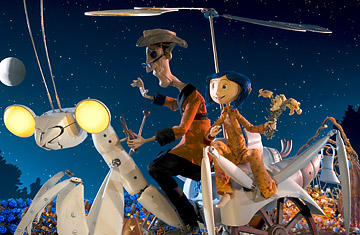
Coraline with "Other Father" in Henry Selick's stop-motion animated 3D movie
(2 of 2)
The Marvels of Stop-motion
Stop-motion is an exacting form of animation in which puppets are posed in a scene, then photographed for a single frame, then moved ever so slightly, then photographed again — and 100,000 or so frames later, presto, you have a feature film. It's been around from the beginning of cinema, since 1898, and for the patient artists behind the scenes, it must seem it takes about that long to finish a movie.
But the form pays off. Generations of TV kids have enjoyed the stop-motion subdivision called Claymation, which produced such scamps as Gumby, the California Raisins and Eddie Murphy's Fox series The PJs. And on the big screen the results can be movie-magical. Among the stop-motion marvels are Willis O'Brien's King Kong; the mythical creatures molded and manipulated by Ray Harryhausen in pictures like Jason and the Argonauts and Sinbad and the Eye of the Tiger; those endearing English eccentrics in Nick Park's Chicken Run and the Wallace and Gromit shorts; the sprightly ghouls of Tim Burton's Nightmare Before Christmas.
"Tim Burton's" was actually Henry Selick's; he directed the film under Burton's supervision. Selick next directed James and the Giant Peach, which managed to improve on the Roald Dahl children's book, and Monkeybone, a pretty frantic mix of live-action and animation. All these films owe less to the chipper confections of Disney, Pixar and DreamWorks than to Euro-cartoonery like The Triplets of Belleville and the work of Czech animator Jiri Trnka.
That goes double for Coraline, and never mind that it's set in rural Oregon. The figures are angular and mostly spindly, like undernourished Europeans after the war; they might be denizens of pestilential Vienna in the 1949 thriller The Third Man. Some of the characters are distinctly European, like Bobolinsky and the theatrical ladies. But even Coraline and the Cat, and certainly Other Mother in her final, spidery metamorphosis, lack the soft lines and winning personalities found in most U.S. animation. Indeed, the girl's "real" environment and her dream-nightmare one are equally remote from the reassuring landscapes in standard American cartoon features. That chilly visual vocabulary, along with a narrative that too often detours into ingenious irrelevancies, makes Coraline an object to be admired, but not embraced.
Selick made the film at Laika, the Oregon animation outfit owned by Nike cofounder Phil Knight. The studio formerly housed the facilities of stop-motion producer Will Vinton, who'd done Oscar-winning shorts and The PJs. Knight, a stockholder in Vinton's company, took over the place essentially to please his son Travis, who'd been a junior animator under Vinton. It's the grand gesture of which only zillionaires are capable. A man sees his child merrily playing with model trains, so he buys the kid Amtrak.
If the Laika story is one of a father's indulgence, Coraline's is about a mother's indifference. It's exactly the kind of book/movie that a writer/animator would dream up to convince his kids that, no matter how much he ignored them while he was doing his important work, they're better off in this family than in any they may dream of joining. As Gaiman puts it, "sometimes the people who love you may not pay you all the attention you need; and sometimes the people who do pay you attention may not love you in the healthiest way." It's a position paper for benign parental neglect — for the security of Kansas over the surface seductions of Oz.
In her "real" world Coraline will get the chance to be a heroine, to vanquish the villains and win her parents' attention (though Real Mother's lips remain Perma-pressed). But the happy ending doesn't dilute the story's moral, obvious enough to stick like a needle in any kid's eye. Both the book and movie warn kids to distrust the kindness of strangers, and find refuge in the prison of the status quo. It's important, Coraline says, for children to learn that real life, though it may be preferable to being devoured by a Spider-Mom, ain't so hot. That lesson is a cautionary preview of their adult years. Don't expect perfection. Life is something not to be looked at through rose-colored glasses. Or 3D glasses either.
